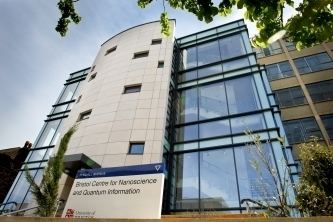Director Prof. Meryn Miles, FRS Phone +44 117 394 0004 | Staff 6 | |
 | ||
Established 7 September 2009 (2009-09-07) Research type BasicAppliedUnclassified Field of research NanotechnologyNanomaterialsNanotoxicologyQuantum informationQuantum optics Faculty ScienceEngineeringMedicine & Veterinary ScienceMedicine and Dentistry Similar University of the West of Englan, University of the West of Englan, The Open University, Exchange, Trinity College Bristol | ||
The Centre for Nanoscience and Quantum Information (informally, NSQI) is a research centre within the University of Bristol. Built as an intra-university facility, the Centre is open to any University researcher working in the nanoscience and quantum information fields. The mission of the Centre is to support world-leading research, as well as provide an interdisciplinary environment that will generate novel and innovative projects that might never have happened in a traditionally divided research establishment. Set in motion by the current Director in 2002 and officially opened in 2009, the Centre was designed to provide a unique ultra-low-vibration research space, making the labs some of the quietest in the world.
Contents
Building layout
The building is split across four floors:
Building design features
The building was designed by Percy Thomas of Capita Architecture, in 2004 and built by Willmott Dixon. The primary requirement for the building was that it be a low-noise research environment, stable enough to allow researchers to take measurements at subnanometre and subnanoNewton resolution, despite other activities going on around them. The criteria set for the research space exceeded any standard curve (VC curves) and required significant design and engineering solutions.
Low vibrations
The primary source of noise for researchers at the nanoscale is mechanical vibration. Activities within a building generate noise that can travel through the structure and vibrations created outside (such as from road traffic) can travel through the ground and enter the building. A variety of methods were employed to reduce vibration generation, travel and entry into the lab space:
Soundproofing
Acoustic noise within the building is countered through several measures. Most importantly, experimental rooms are far from the busy University precinct, underground and in an area that is not used for teaching, or as a thoroughfare. The thickness of the floor ensures that little sound penetrates across and the walls between labs and doors of the labs are soundproof. The plant machinery is removed as far from the labs as possible, on the top floor, and the services are tuned as precisely as possible to reduce any sounds from the water supply, chilled water system or air vents.
Low electrical noise
Many of the experiments planned for the Centre involve recording tiny electrical currents (as low as a few picoAmps) so electrical noise is seen as a serious problem. Each basement research lab is a full Faraday cage, all service pipework changes to plastic before entering the lab and no Category 5 cable (cat5e) is used in data network, optical fibre is used instead. All labs are also supplied with an independent earth and 'clean' power supply, the mains having been filtered by a 1:1 transformer.
Interdisciplinary space
In addition to providing state-of-the-art low noise spaces, the building is also designed to encourage collaboration and interdisciplinary research. This includes plenty of meeting spaces and a light & spacious foyer/coffee area.
Directors
Previous Directors include Professor Daniel Robert, Professor Steve Wiggins and Professor Robert Evans.
Management Committee
The management committee provides advice and direction on the management of the Centre and assesses the project applications for researchers who wish to use the Centre. Current members are: Mervyn Miles (Physics; Director of NSQI); H.X.Peng (Aero-engineering; Deputy Director); Fred Hale (Centre Manager); Charl Faul (Chemistry; Centre User & BCFN co-ordinator); Henkjan Gersen (Physics; Centre User & BCFN co-ordinator); George Banting (Biochemistry); Margaret Saunders (BIRCH, Medical Biophysics; Centre User); and Jeremy O'Brien (Electrical & Electronic Engineering (EEE) and Physics; Centre User).
Research Strategy Group
This group steers the direction of Nanoscience and Quantum information research support across the University of Bristol. This is a University-wide community and is not restricted to research and researchers working in the building. Current members are: Mervyn Miles, John Rarity (EEE; Centre User); Daniel Robert (Biological Sciences; Centre User); Annela Seddon (BCFN & Physics; Centre User); Ruth Oulton (Physics and EEE; Centre User); Tannie Liverpool (Mathematics); Mark Dillingham (Biochemistry); Dek Woolfson (Chemistry and Biochemistry); and Siyuan Yu (EEE; Centre User).
